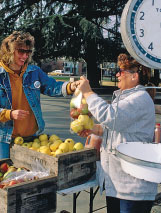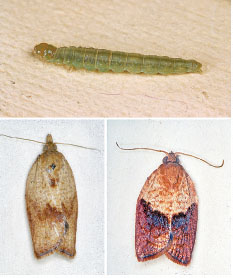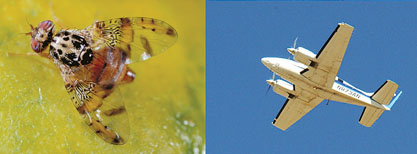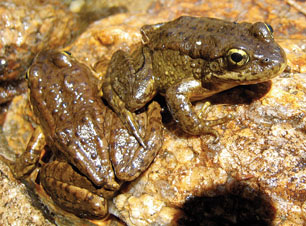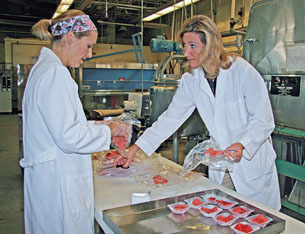All Issues
Science briefs: October-December 2007
Publication Information
California Agriculture 61(4):149-151.
Published October 01, 2007
PDF | Citation | Permissions
Full text
Farmers' markets benefit growers, local economies
Direct-marketing venues such as farmers' markets help farmers sell their products in local communities for higher prices than they could get from wholesalers, according to a UC food systems analyst who reviewed studies of the markets and their growth.
“Farmers benefit from the ability to sell smaller and variable quantities, and learn the skills they need to increase their business,” says Gail Feenstra of the UC Sustainable Agriculture Research and Education Program (SAREP). Her article appeared in the January 2007 “Food for Thought” issue of the Italian journal Gastronomic Sciences.
In 1970 there were 340 farmers' markets in the United States; by 2006, there were more than 4,385 farmers' markets, Feenstra says. California has almost 500 markets, half of which are open year-round.
Farmers, communities and individual residents are the main beneficiaries of local farmers' markets, Feenstra says.
The total gross receipts that farmers receive at farmers' markets, although modest by comparison to supermarkets, are still significant. Her 1999 study of California farmers' markets estimated total annual sales at approximately $140 million.
Likewise, “the social benefit that farmers' markets bring to communities can't be overestimated,” Feenstra says. In her interviews with market patrons, she found them to be a major source of interaction, both between farmers and their customers, and among market visitors.
Low-income and elderly community residents receive particular benefits from farmers' markets, Feenstra says, where healthful, affordable, nutritious food or ethnically appropriate foods are more likely to be available than at retail food outlets.
For more information: http://www.unisgjournal.it/index_eng.htm.
IPM pub focuses on light brown apple moth
Aircraft sprayed pheromones in parts of Monterey County in early September and are now targeting Santa Cruz in an effort to disrupt mating and eradicate a ravenous new exotic pest, the light brown apple moth. An aggressive 11-county program is targeting the dime-sized moth from Australia, Epiphyas postvittana, which attacks more than 250 plant species.
UC Statewide Integrated Pest Management Program has produced a new publication to answer questions about moth identification, its biology, and management alternatives and regulation. The free online guide was produced by about 10 scientists from the United States and two other countries.
Since the first detection on Feb. 27 in Berkeley (Alameda County) trappers have captured more than 7,700 specimens in 11 counties (through Sept. 14), according to Kevin Hoffman, primary state entomologist with the California Department of Food and Agriculture (CDFA). Counties affected are Alameda, Contra Costa, Los Angeles, Marin, Monterey, Napa, San Francisco, San Mateo, Santa Clara, Santa Cruz and Solano. (The moth previously invaded New Zealand, the United Kingdom, Ireland and Hawaii.)
The U.S. Department of Agriculture (USDA) announced Aug. 10 an infusion of $15 million in federal funding to fight the infestation. This allows the Cooperative Light Brown Apple Moth Eradication Project to move forward to protect the environment and prevent the spread of the moth elsewhere in the United States.
Top, larva of the light brown apple moth; bottom left, the female, and right, male moths. Adults are about three-quarter-inch long.
The pest damages a wide variety of crops, including grapes, citrus and stone fruits (peaches, plums, nectarines, cherries, apricots), as well as common landscape trees such as cypress, redwoods and oaks and numerous other varieties found in urban-suburban landscaping and the natural environment.
Nursery products are especially vulnerable because many are shipped outside the affected counties to other states and internationally. The USDA Animal and Plant Health Inspection Service and CDFA have implemented interstate and intra-state quarantines.
To download a free copy of “Light Brown Apple Moth: Quarantine, Management, and Potential Impacts,” go to: http://www.ipm.ucdavis.edu/EXOTIC/lightbrownapplemoth.html.
Medfly outbreak in Dixon
Agricultural officials are taking action against a Mediterranean fruit fly infestation detected within the city limits of Dixon in northern Solano County. Within a 5-day period from Sept. 10 to 14, officials found 12 adult Medflies at five sites, and 33 larvae in a single peach tree in a back yard.
Left, the Mediterranean fruit fly is smaller than a housefly. Right, In mid-September, CDFA began aerial releases of millions of sterile male Medflies in and around Dixon.
“It's definitely breeding, but it's all within the city of Dixon so far,” says Kevin Hoffman, primary state entomologist with the California Department of Food and Agriculture (CDFA). “We want to keep them from infesting the commercial crops.”
This is the first time that Medfly has been discovered in Solano County and the second time in the 400-mile Central Valley. Dixon is about 20 miles southwest of Sacramento.
Smaller than a housefly, the Medfly is considered one of the world's worst agricultural insect pests due to its wide distribution, wide range of hosts and ability to tolerate cool climates. Its larvae infest more than 260 fruits, vegetables and nuts. First detected in California in 1975, Medfly particularly threatens thin-skinned fruits such as peach, nectarine, apricot, avocado, grapefruit, orange and cherry. According to CDFA Secretary A.G. Kawamura, its permanent presence in California could result in annual losses of $1.3 billion to $1.8 billion.
The CDFA Medfly Action Plan kicked into high gear immediately following the initial find, Hoffman says. The action plan includes: stripping all fruit from trees within a 100-meter radius of all Medfly finds; ground-spraying the organic compound Naturalyte (the active ingredient is spinosad, a naturally occurring product of a soil bacteria) within a 200-meter radius; setting 1,700 fruit fly traps within an 81-square-mile grid in all of Dixon and the surrounding area; and aerially releasing 1.5 million sterile male Medflies (dyed pink for easy detection) on Sept. 14 over a 12-square-mile area, with weekly releases of 3 million sterile Medflies for at least 9 months. CDFA also established a 114-square-mile quarantine area, and the command center at the Dixon May Fair grounds will be in operation for at least a year.
Unlike earlier Medfly infestations in California (the seven-county Bay Area infestation in 1980, and the 1989–90 and 1993–94 infestations in Southern California), which involved aerial spraying of the controversial insecticide malathion, the Dixon infestation deploys spinosad.
“Spraying of the spinosad bait is a safe approach,” UC Davis entomologist Frank Zalom says. “It has been used successfully by our growers to treat olive fruit flies, and it has been used successfully in Hawaii to suppress there.”
Likewise, releasing sterile male flies “has a proven track record in Southern California of breeding with wild females to help achieve eradication,” says Steve Lyle, director of CDFA's Office of Public Affairs. “The females breed once and if they breed with a sterile male that ends their reproductive activities.”
To report infested fruit, call CDFA at (800) 491–1899, or go to: http://www.cdfa.ca.gov. For more information, go to: http://entomology.ucdavis.edu/news/medfly infestation.html.
Flies could transmit exotic Newcastle disease between poultry
Laboratory testing shows that flies exposed to a food source infected with exotic Newcastle disease (END) can pick up the virus and carry it for several days, perhaps later passing it on to chickens that eat the food.
“Flies can carry END virus and evidence is mounting that flies may be able to transmit the virus between chickens,” says Alec Gerry, UC Riverside assistant veterinary entomologist.
END is a contagious and fatal viral disease affecting the respiratory, nervous and digestive systems of poultry and other birds. “END is so infectious that many birds die without ever showing signs of illness,” Gerry says.
In 2002 and 2003, an END outbreak in California resulted in the quarantine of nearly 20,000 buildings, the destruction of 3.2 million birds, and eradication efforts that cost $170 million.
UC Riverside postdoctoral associate Seemanti Chakrabarti found that flies (bronze blow fly, housefly and little house fly) routinely contract infectious END virus at locations where chickens are also infected. Presumably, flies are making contact with the virus when they land or feed on poultry manure containing the virus.
“Conservatively, flies should be considered as transmitters of the END virus,” Gerry says. “This means that fly control should be an important part of a biosecurity program at all poultry operations.”
More flavonoids in organic tomatoes, study shows
Tomatoes grown organically at the UC Davis Long-Term Research on Agricultural Systems project (LTRAS) had significantly higher levels of two important antioxidants, according to a study in the June 2007 Journal of Agriculture and Food Chemistry.
“The is the first time that a study has shown well-quantified changes in tomato nutrients over a period of years in organic farming systems,” says lead author Alyson E. Mitchell of the Department of Food Science and Technology and Department of Plant Sciences at UC Davis.
Dried tomato samples were collected between 1994 and 2004 from LTRAS plots, a 100-year project that began in 1993 to compare organic, sustainable and conventional practices. The organic tomatoes had significantly higher (P < 0.05) levels of the flavonoids quercetin and kaempferol; the 10-year mean levels were 79% and 97% higher, respectively, than those in conventionally grown tomatoes.
Fruits and vegetables are a primary source of flavonoids and other antioxidants in the diet. Epidemiological studies suggest that they may protect people who eat more produce against cardiovascular disease and, to a lesser extent, against cancer and age-related diseases such as dementia.
In this study, the levels of flavonoids increased over time in samples from organic treatments, whereas flavonoids did not vary significantly in conventional treatments. “This increase corresponds not only with increasing amounts of soil organic matter accumulating in the organic plots but also with reduced manure application rates once soils in the organic systems had reached equilibrium levels of organic matter,” Mitchell and coauthors wrote.
The authors theorized that over time, plants grown in organically managed soils — those treated with compost, manure and cover crops, rather than synthetic fertilizers — can devote more energy to producing flavonoids and may be less susceptible to pest pressures.
Alyson Mitchell (right) and graduate student Joy Rickman examine dried tomatoes at the UC Davis food science lab.
For more information: http://mitchell.ucdavis.edu .
Frog-killing fungus may be spread by reproduction
A deadly fungus that has decimated populations of mountain yellow-legged frogs in the Sierra Nevada can likely be spread by sexual reproduction, seriously complicating efforts to save the frogs from extinction, according to a new genetic analysis by UC Berkeley researchers.
The dramatic decline of the mountain yellow-legged frog over the past several decades has been attributed to the introduction of nonnative predatory fish in some areas and to chytridiomycosis, a quickly spreading disease caused by a waterborne fungus, Batrachochytrium dendrobatidis.
The study, which appeared in Proceedings of the National Academy of Sciences in August, suggests that the frog-killing fungus may end up playing the bigger role in the frog's demise because of the pathogen's ability to spread over long distances and possibly persist in the environment as a consequence of sexual reproduction.
“This group of fungi, when it reproduces sexually, can create spores that can last for a decade,” says John Taylor, UC Berkeley professor of plant and microbial biology. “That could make this pathogen a harder problem to defeat. As a resistant spore, the fungus could be transported by animals, including humans or birds, or lay dormant in an infected area until a new host comes along.”
In the western United States, the fungus has been spreading quickly, moving west to east across the Sierra Nevada at a pace of about a mile per year, according to the researchers. Tens of thousands of mountain yellow-legged frogs in hundreds of sites have virtually disappeared in the wake of the pathogen's emergence in the area.



